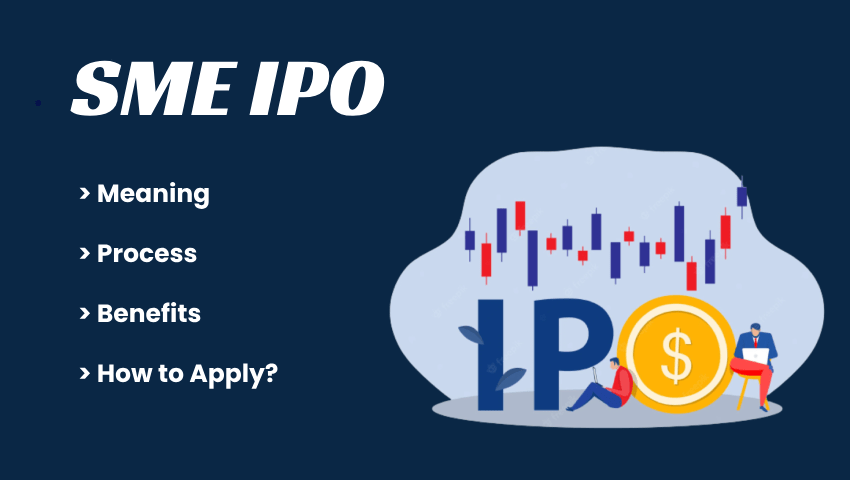
- 15/07/2025
- MyFinanceGyan
- 673 Views
- 2 Likes
- Share Market
SME IPO: Meaning, Process, Benefits, and How to Apply?
Small and Medium Enterprises (SMEs) are important for our country’s economy. Many small businesses want to grow but face problems getting funds. One way to raise money and grow is through an SME IPO. Let’s understand what it is, how it works, and how it helps.
What is an SME IPO?
SME means Small and Medium Enterprises. IPO means Initial Public Offering, where a company sells its shares to the public for the first time. So, SME IPO means a small or medium company offering its shares to the public to raise money. These IPOs follow simpler rules compared to big companies’ IPOs. This helps small businesses raise funds directly from the stock market.
SME Classification in India:
SME IPO Eligibility Criteria:
To launch an IPO, an SME must meet these conditions:
- Registered under the Companies Act, 1956
- After issuing shares, total capital must be less than ₹25 crore
- Net assets of at least ₹1.5 crore
- If formed by converting a partnership or LLP, must have 3 years of business history
- Must have a working website
- Promoters (owners) should not change for 1 year
- Shares must be traded in Demat form
- Should sign an agreement with depositories like NSDL or CDSL
Where Are SME IPOs Listed?
There are two main platforms for SME IPOs in India:
- BSE SME (by Bombay Stock Exchange)
- NSE Emerge (by National Stock Exchange)
SEBI & BSE Rules for SME IPOs:
SEBI Guidelines:
- IPO size: Between ₹10 crore to ₹25 crore
- Minimum 50 investors required
- Capital after issue: Minimum ₹10 crore
- Lock-in period for promoter’s shares: 3 years
- Retail investor application size: Minimum ₹1 lakh
BSE Guidelines:
- Net assets: Minimum ₹3 crore
- Net worth: Minimum ₹3 crore
- Profits in 2 out of last 3 years or net worth of ₹5 crore
SME IPO Process – Step-by-Step:
- Hire a Merchant Banker (Underwriter)
- They help prepare all documents and guide the process.
- Create Draft Red Herring Prospectus (DRHP)
- This document gives investors all company details and plans.
- Submit DRHP to Stock Exchange
- Not to SEBI, but directly to NSE/BSE for SMEs.
- Announce IPO Dates
- After approval, the IPO launch date, price, and lot size are shared.
- IPO Launch and Share Allotment
- Investors apply for shares. After the IPO closes, shares are allotted and listed.
Difference Between Regular IPO and SME IPO:
Benefits of SME IPO:
- Raise Capital: Helps SMEs get money to grow their business.
- Brand Recognition: Increases trust among customers and partners.
- Exit for Early Investors: Founders and early investors can sell shares.
- Employee Motivation: Shares can be given as rewards to employees.
- Better Valuation: Listed companies are often valued higher.
- Good Governance: Improves transparency and management.
- Mergers & Acquisitions: Shares can be used for buying other businesses.
- Discipline: Being public adds pressure to perform better.
- Stronger Brand: Media coverage boosts the company’s name.
How to Invest in SME IPOs?
- Open a Demat Account
- If you don’t have one, open it with a broker or bank.
- Check Minimum Investment
- Usually ₹1 lakh for retail investors.
- Apply through Broker Platform
- Log in to your broker’s app or site, go to SME IPO section.
- Fill Details and Pay
- Select number of lots, pay via UPI, and confirm your order.
- Wait for Allotment
- After allotment, shares will reflect in your Demat account.
Impact of SME IPOs on Indian Economy:
- Helps small businesses grow faster
- Creates more jobs
- Attracts more investors to small companies
- Boosts innovation and competition
- Supports local communities and industries
Challenges & Risks of SME IPOs:
- High Cost: Legal, audit, and listing fees are expensive
- Takes Time: Process needs planning and effort
- Market Fluctuations: Prices may drop due to market changes
- Rules & Compliance: Need to follow many new laws
- Low Liquidity: It may be hard to sell shares quickly
Tips for SMEs Before Going Public:
- Check if business is stable and ready
- Make a strong business plan
- Value the company correctly
- Build a good management and advisory team
- Communicate openly with investors
- Focus on long-term success, not just short-term profit
In Conclusion…
SME IPOs are a great way for small businesses to grow, get funding, and build their name in the market. Yes, there are risks, but with good planning and right guidance, many SMEs have become successful after going public.
FAQs:
SME IPOs can offer high returns but also come with higher risks. Study the company well before investing.
It’s the market for small and medium businesses that are not yet big enough for regular IPOs.
It’s a type of IPO specially designed for SMEs to raise public funds.
Once you get shares in your Demat, you can sell them through your broker on the SME exchange.
Open a Demat account → Apply via broker → Pay using UPI → Wait for allotment → Shares come to your Demat.
Disclaimer:
This blog is only for educational purposes and not meant to give any financial advice or product recommendation.



